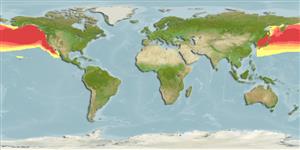Environment: milieu / climate zone / depth range / distribution range
বাস্তুসংস্থান
সামুদ্রিক সমুদ্রবক্ষে ভাসমান (ব্যথিপেলাজিক); গভীরতার পরিসীমা 16 - 1267 m (Ref. 96339). Deep-water; 66°N - 21°N, 128°E - 109°W
North Pacific: Bering Sea to Japan, and Baja California, Mexico.
আকৃতি / ওজন / Age
Maturity: Lm ? range ? - ? cm
Max length : 15.0 cm TL পুরুষ/ লিঙ্গ অনিধর্ারিত ; (Ref. 87380)
পৃষ্ঠীয় কাঁটা (মোট ) : 0; পৃষ্ঠীয় নরম পাখনা দন্ড (মোট ) : 11; পায়ূ কাঁটা : 0; পায়ূর নরম পাখনা্তুন্ড: 14. This species' most striking feature is the transparent, cowl-like shield that covers the top of the head, and its prominent tubular eyes within. The shield is a tough, flexible integument that attaches to the dorsal and medial scales behind the head, and to the broad, transparent subocular bones that protect the eyes laterally. The fluid-field chamber found beneath the shield surrounds and protects the eyes with vivid green lenses. The tubular eyes of this fish can look forward as well as upward (with maximum arc of rotation observed about 75 degrees). The morphology of the eyes apparently allow at least two feeding modes: (1) with body horizontal and with eyes directed upward, it can spot food against lighted waters above, it pivots its body to bring the mouth up for ingestion while eyes are locked on target, rotating from dorsal to rostral relative to the body; and (2) with body horizontal, eyes rotate dorsal to rostral while tracking the path of descending food until it reaches the level of the mouth (Ref. 87379). Adipose at the base of the caudal peduncle (Ref. 6885). Adults dark brown (Ref. 6885).
A solitary fish, occurring at lower mesopelagic depths beneath temperate and subarctic waters. Caught by midwater trawl nets in areas with bottom depths of 1600-3600 m. Stomach contents include cnidarian remains, however, its visceral anatomy suggests diets of mixed zooplankton, including both gelatinous and crustacean prey and siphonophore tentacles and nematocysts (Ref. 87379). Uncommon species (Ref. 6885). Oviparous, with planktonic larvae (Ref. 35626). A photo of a 15 cm long fish shown at http://www.newscientist.com/gallery/new-species/9.
Life cycle and mating behavior
পরিপক্কতা | প্রজনন | ডিম ছাড়া | ডিমসমূহ | ডিম্বধারন ক্ষমতা | শুককীট
Eschmeyer, W.N., E.S. Herald and H. Hammann, 1983. A field guide to Pacific coast fishes of North America. Boston (MA, USA): Houghton Mifflin Company. xii+336 p. (Ref. 2850)
IUCN Red List Status (Ref. 130435: Version 2024-2)
Threat to humans
Harmless
Human uses
মৎস্য:
হাতিয়ার
Special reports
Download XML
ইন্টারনেট সুত্র
Estimates based on models
Preferred temperature (Ref.
123201): 0.6 - 6.8, mean 3.7 °C (based on 175 cells).
Phylogenetic diversity index (Ref.
82804): PD
50 = 1.0000 [Uniqueness, from 0.5 = low to 2.0 = high].
Bayesian length-weight: a=0.01122 (0.00514 - 0.02450), b=3.04 (2.87 - 3.21), in cm total length, based on all LWR estimates for this body shape (Ref.
93245).
ট্রফিক পর্যায়ে (Ref.
69278): 3.6 ±0.1 se; based on size and trophs of closest relatives
স্থিতিস্থাপক (Ref.
120179): উচ্চ, সর্বনিম্ন প্রজন দ্বিগুনের সময় ১৫ মাস (Preliminary K or Fecundity.).
Fishing Vulnerability (Ref.
59153): Low vulnerability (10 of 100).
